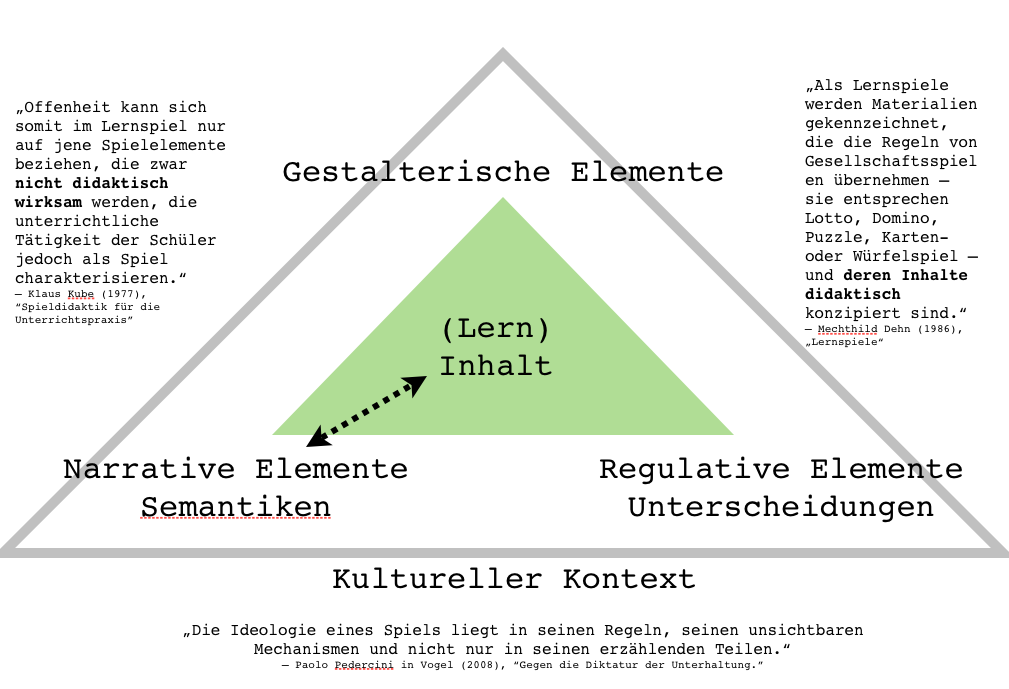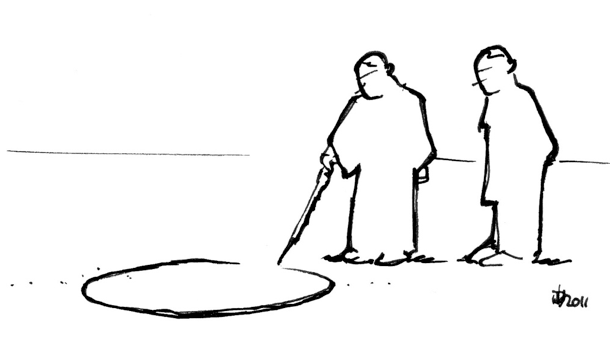(Regel)Spiele setzen sich zusammen aus narrativen, regulativen und ästhetischen Elementen, wobei sich die drei Bereich gegenseitig durchdringen: In einem idealen, designtechnisch integriertem Spiel ergänzen und verstärken sich Rahmenerzählung, Regeln und ästhetische Gestaltung. Gegenläufige Verwendungen, z.B. die hohe Rolle des Geldes oder die gefälschten Würfelwürfe bei “eLections – Your Adventure in Politics”, einem Spiel, das die US-amerikanische Demokratie erklären soll, führen ggf. zu einem irritierenden Spielerlebnis (= in der US-Amerikanischen Politik wird geschummelt und der mit dem meisten Geld gewinnt vermutlich). Dies wäre bei Unusable Games aber durchaus erwünscht.
Archiv der Kategorie: narratives
Some Game Design Approaches
As impressive as most commercial games look like, ’new‘ games rely mostly on skinning (signs and stories), slight modding (rule systems), recombination and maybe some additional extras – to already known and successful games and game mechanics. Weiterlesen
The absence of a sign is the sign of an absence
It may seem counter intuitive, but an empty space may be as expressive in specific circumstances as would be a present object. Of course there are obvious taboos in a society that deliberately lead to an absence of a sign, although the object, process, system itself is present, maybe even formative for the culture. This is more a conscious renouncement, like the omission of specific politically uncorrect expressions (see? I did it – no examples given).
The categories are sometimes blurred, but the more dire version of an absence of signification is the one one can not see from within the system of signs one uses to handle the world. These absent signs lie in the blind spot of cognisance that Heinz von Foerster describes as metaphor for things we won’t know and systemically won’t know that we won’t know them – thus, with this metaphor, creating a sign for something not easily expressable before. You can find the physiological phenomenon and an experiment described here.
For culture, this may be the omission of systemic forces in political discourse in a liberal market society, with a demand of a high degree of autonomy and responsibility from its ‚free‘ participants; or the seemingly wide spread notion of persons of wealth and power in our societies, that they just shape the ‚content‘ – e.g. power, money, concrete decisions – by entitlement of ‚hard work‘, ‚expertise‘ etc.; and not the ‚rules‘ within these decisions are made; or how ‚hard work‘ or ‚expertise‘ is defined. A good example to render this kind of blind spot visible is Garry Shirts‘ 1969 famous game of „Starpower“. Weiterlesen
Spieldesignbeispiel: Ärgere-Das-Simulacrum
 Jede Spielentwicklung verläuft anders, aber ich versuche hier mal ein Beispiel zu geben, wie sich meine Spielidee um eine weitere Mensch-Ärgere-Dich-Nicht-Variante allmählich entwickelt. Dabei decken unterschiedliche Spieldesignmethoden unterschiedliche Zielvorgaben ab: Das Spiel soll eine andere bzw. erweiterte Narrationsform bekommen (Skinning) und daran angepasst andere bzw. mehr Regeln (Modding) erhalten. Es wird dadurch komplexer, soll aber trotzdem noch ausbalanciert im Spiel sein (Akkretion und Tuning bzw. Balancing). Durch die Übertragung massenmedial präsenter Narrationen (Filmclichés) in eine Regelform geschieht ebenfalls eine – wenn auch sehr simple – transmediale Übertragung.
Jede Spielentwicklung verläuft anders, aber ich versuche hier mal ein Beispiel zu geben, wie sich meine Spielidee um eine weitere Mensch-Ärgere-Dich-Nicht-Variante allmählich entwickelt. Dabei decken unterschiedliche Spieldesignmethoden unterschiedliche Zielvorgaben ab: Das Spiel soll eine andere bzw. erweiterte Narrationsform bekommen (Skinning) und daran angepasst andere bzw. mehr Regeln (Modding) erhalten. Es wird dadurch komplexer, soll aber trotzdem noch ausbalanciert im Spiel sein (Akkretion und Tuning bzw. Balancing). Durch die Übertragung massenmedial präsenter Narrationen (Filmclichés) in eine Regelform geschieht ebenfalls eine – wenn auch sehr simple – transmediale Übertragung.
Die Idee eines postmodernen Mashup von MÄDN wurde inspiriert von den unübertrefflichen TV-Tropes sowie von Mark A. Rayners ebenso simplen wie faszinierenden Stein-Schere-Papier-Variante. Weiterlesen
Weiterlesen
„Zitat“
Due to recent events – the public interest in Guttenberg-practice-of-quoting – I’d like to post an article on the topic which originally was published in „La réalité dépasse la fiction.“
Zitat
Zi•tat, das; von lat. citare (=herbeirufen). Ein einzelnes mediales Fragment bzw. Formelement aus einem bereits existierenden Werk, das in einer Neukontexualisierung einen Bezug zu diesem herstellt. In Wissenschaft, Juristik und Religion beliebt als legitimierende bzw. exemplifizierende Referenz, in der Ästhetik meist als Hommage oder Parodie bzw. als sicherer Plagiatsersatz für Künstler anzutreffen [siehe Marketing]. Das übliche fremdreferenzielle Zitat leistet dabei eine vernetzende sowie stabilisierende und Identität stiftende Wirkung auf kultureller, das Selbstzitat auf individueller Ebene. Insbesondere in einer zunehmend beschleunigten Welt im Wandel erhalten Zitate durch ihr Wesen der Beständigkeit und Abgeschlossenheit die Rolle von unveränderlichen Orientierungspunkten – oder zumindest als Schnappschüsse von diesen. Weiterlesen
Causality in history: Chrononauts
„Chrononauts is a fascinating, whimsical exploration of time travel, causality, and possibility covering many fascinating and significant events of the last century or so.“
– Andrew Looney
„Chrononauts“ by Anrew Looney (2000) is a card-based game where the players play time travellers able to alter historical events by flipping specific cards, linchpins of the timeline. Those altered events may cause a ripple effect by altering follow-up events, some quite obvious, some funny and nifty: Why would the New York World Fair 1939 have German Cake in an alternate timeline?
Visual analysis of gamebooks
Gamebooks were, during the 80ies and before the rise of PCs and the internet, a staple of interactive fiction. Back then, the next best thing to sitting together with some friends and playing a face-to-face roleplaying game was reading these branching, directed hypertexts in the form of books.
Each paragraph had a number on top, and at the end there was the number of the next paragraph to be read. Sometimes a decision had to be made, e.g. doing something or refraining from it, that would lead to two different parapgraphs.
Two medium-relevant motivations drove me, back then: I wanted to ’solve‘ the text, i.e. bringing the path to a satisfiying ending; and I wanted to know what would have happened if my decisions earlier on were different ones. The latter one would usually take over when the text had been solved – a classic example for the replayability of a simplified narrative possibility space („The Tree“).
Screenshot from the animation of the pathways of „The Mysterys of the Secret Room“.
For a beautifully visualised and animated depiction of a reader’s possible paths of ten gamebooks, a description of specific path-formations, and an evolutionary analysis of „Choose your own adventures“ narrative structures – or if you simply had been a fan yourself in the heydays of gamebooks – visit this site: CYOA.
There’s also a path, beautifully documented on the webpage, to second order gaming, to systemic theory or to radical constructivism to be found in one gamebook:
„This ending was not just an easter egg for the obsessive reader who didn’t mind skimming every page looking for telltale words. Instead it’s hard to miss in even a casual riffling. A two-page illustration showing what could only be paradise (or perhaps a theme park) leaps out as the only spread in the book without any text. Flipping to the page before brings you to 101, where you discover that your curiosity has been rewarded.
You have found the planet, not by following the constraints of the system, but by going outside of them – a fitting moral to the story and an encouraging reminder that any game should be a starting point for the imagination, not the end.“
Some things can’t be chosen from within the system of rules one adheres to, but has to be discovered or invented by breaking or transcending those boundaries.
The modest artist/writer doesn’t explicitely states his name, but from the story presented I take it to be Steve Meretzky.
This is an extraordinary, and extraordinary beautiful website.
Further readings:
- Luhmann’s „Zettelkasten“
- Crowder’s branching programmed instruction approach
- Comparing branching Gamebooks‘ storylines to programming: Jeff Atwood
- Play gamebooks online at the Fighting Fantasy Project
- Fabled Lands. Gamebooks with non-branching narrative pathworks, more closely related to The Garden than The Tree
- „The Garden of Forking Paths“ (1941) by Jorge Luis Borges (full text), probably the earlies description of a hypertext-novel
A cabbalistic riddle
Radical constructivism may find an aesthetic counterpart in beautifully crafted educational narratives used for example in cabbalistic teaching and Zen-buddhism. These short stories are often recursive, layered, or self-denying because of their complex topics (e.g. existence, epistemes, agency), but nonetheless beautiful to behold.
One fine example, though quite concrete, is this cabbalistic riddle:
A young student once asked a renowned teacher about the nature of knowledge. The teacher drew a circle in the sand and explained: Within this circle is that, what we know, and on the outside is that, what we do not know.
We may build our lives on what is within the circle, getting proficient and skilled in the application of what we know. We may also strive to learn what is on the outside, on what we will know one day or may never know at all, becoming proficient and skilled in widening the circle. Or we may think about the thin line of the circle itself, of how it is created, and what its nature and purpose may be.
In a similar three-step-approach, though maybe less accessible and with a different goal, we encounter a short koan from Hui-Neng, taken from „The Gateless Gate“:
Two monks were watching a flag flapping in the wind.
One said to the other, „The flag is moving.“
The other replied, „The wind is moving.“
Huineng overheard this.
He said, „Not the flag, not the wind; mind is moving.“
Games and the „best way“ to tell stories
Torsten Meyer (thanks!) just sent me a link to a recent interview with game designer Peter Molyneux, published in the „Tageszeitung“, the title translates as „Fable-Gamedesigner Peter Molyneux: A visionary and charlatan“
Molyneux is quite enthusiastic about interactive-adaptive stories as games, but omits other aspects of the relation of „story“ and „game“ resp. „play“ which I think are quite important.
If there’s the question „How can stories in games ever compete with books and movies?“, one may have fallen to an error of categorisation. Stories in games have to deal with similar problems as texts in the digital medium: They are easily seen as simple transfers from previous technical media, but basically the same as before, a linear progression of meaningful – or dramatically arranged – information.
Weiterlesen
The teacher as hero
A hero (…) is a (mostly male) person with exceptional abilities or traits, driving him to exceptional feats, so called heroic deeds.
Wikipedia „Held“ (Dec 6th 2008), translated from german
Don’t we all wish for us to make a difference for what we do, to achieve greatness, and to get apprehension for this? As well as artists, doctors, politicians, soldiers and fighters do teachers and mentors of all kind find their way into medial representation. Best known, probably, are teachers in mainstream movies. You can probably put up a set of teacher-archetypes as diverse as in any fairy-tale cast. Movies like the german „Feuerzangenbowle“ come to mind, where we get three clichees to compare: The beloved put disrespected kind one, the stern but fair one, or the authoritarian despised one. But there are also more recent movies, with archetypes of eastern (the ubermensch, the fool) and US-american cultural ilk (the victim, the physical fighter, the heartthrob)




